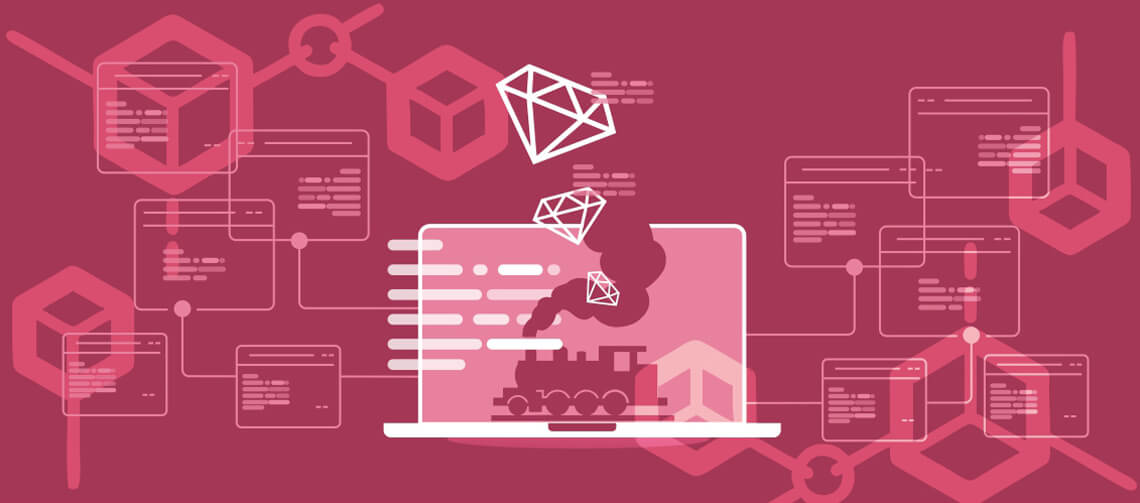 In addition to being a general purpose programming language, Ruby supports object-oriented, functional, and imperative programming paradigms. The programming language further focuses on simplicity and productivity. Its expressive syntax rules enable programmers to build web applications by writing natural-to-read code. Many developers even opt for Ruby to create prototypes without putting extra time and effort.
In addition to being a general purpose programming language, Ruby supports object-oriented, functional, and imperative programming paradigms. The programming language further focuses on simplicity and productivity. Its expressive syntax rules enable programmers to build web applications by writing natural-to-read code. Many developers even opt for Ruby to create prototypes without putting extra time and effort.
.
But the developers cannot write large and complex web applications in Ruby without leveraging web frameworks. The tools, libraries, and utilities provided by Ruby web frameworks enable programmers to write web applications according to varied business requirements. The developers can even simplify and accelerate custom web application development by availing a number of web frameworks for Ruby.
10 Widely Used Ruby Web Frameworks Developers must Use in 2018
Ruby on Rails
Ruby on Rails is the most popular web framework for Ruby programming language. The full-stack web framework comes with features to facilitate both client-side and server-side web development. It provides the basic structure required by developers to create web pages, web services, and databases. Also, it enables developers to build user interfaces by combining HTML, CSS, JavaScript, and XML. Also, Ruby on Rails developers have the option to add functionality to the web applications without writing additional code by using a variety of robust Ruby gems.
Sinatra
Unlike other web frameworks for Ruby, Sinatra is designed as a domain specific language (DSL). The web developers can leverage Sinatra as an open source web application library. Sinatra, unlike other Ruby web frameworks, does not support model-view-controller (MVC) architectural pattern. But the developers can use it as a simple and lightweight framework to write a variety of web applications rapidly in Ruby.
Padrino
The open source Ruby framework is developed based on Sinatra. Despite being a simple and lightweight framework, Padrino comes with features to simplify the development of web applications of varied types and scales. It further accelerates custom web application development by providing a drop-in admin Interface that includes ORM, template, authentication, and scaffold. Padrino even allows developers to work with a number of testing and database libraries.
Cuba
Cuba is designed as a micro web framework for Ruby. The developers can speed up custom web application development by using Cuba as a fast and lightweight. Cuba further helps developers to build high-performing web applications by providing only useful and relevant features. However, the developers still have option to extend Cuba by integrating templates and testing libraries.
Hanami
Hanami (earlier known as Lotus) is a lightweight web framework for Ruby. Despite being a young Ruby web framework, Hanami simplifies custom web application development by enforcing good code structure and providing ready-to-use libraries. The features provided by Hanami even enable programmers to speed up websites without increasing memory consumption. The number of Ruby programmers switching to Hanami has been increasing consistently.
Roda
This uses the routing tree, which allows a developer to have DRYer code. It supports immutability and its apps are designed to be frozen in production, which eliminates thread safety issue. Due to having low per-request overhead and intelligent caching of internal data structures, it is significantly faster than other frameworks in ruby..
Goliath
Goliath is designed as a lightweight Ruby web framework. The web developers can even use it as a non-blocking version of Ruby web server framework. In addition to supporting asynchronous processing, Goliath helps programmers write maintainable code. It even simplifies web application development by providing rack API and middleware support.
Scorched
The lightweight Ruby web framework simplifies web application development by optimizing HTTP request processing. It processes HTTP requests quickly and efficiently through a set of robust constructs. The constructs even help developers to build web applications of varied types and scales. The developers even have the option to use Scorched just like Sinatra framework.
Pakyow
This framework lets the developer implement the UI without worrying about the business logic, this is known as the View-First process which updates the presentation layer with the data without moving code to the client. It provides the new style of development which lands in between traditional and modern client-side framework.
Trailblazer
It is the framework on top of ruby on rails which provides the solutions to fat model architecture by adding smaller components for different concerns. It introduces better abstraction layers, structure and reasonable encapsulation by extending the traditional MVC pattern, which helps developers to maintain their code in a better way.
On the whole, the developers have option to choose from an array of web frameworks for Ruby programming language. Most of these web frameworks are open source and free. Some of these web frameworks facilitate full-stack web development, whereas as others are simple and lightweight. But the Ruby developers must remember that each Ruby web framework has its own pros and cons. Hence, they must compare these Ruby web frameworks according to precise needs of individual projects.